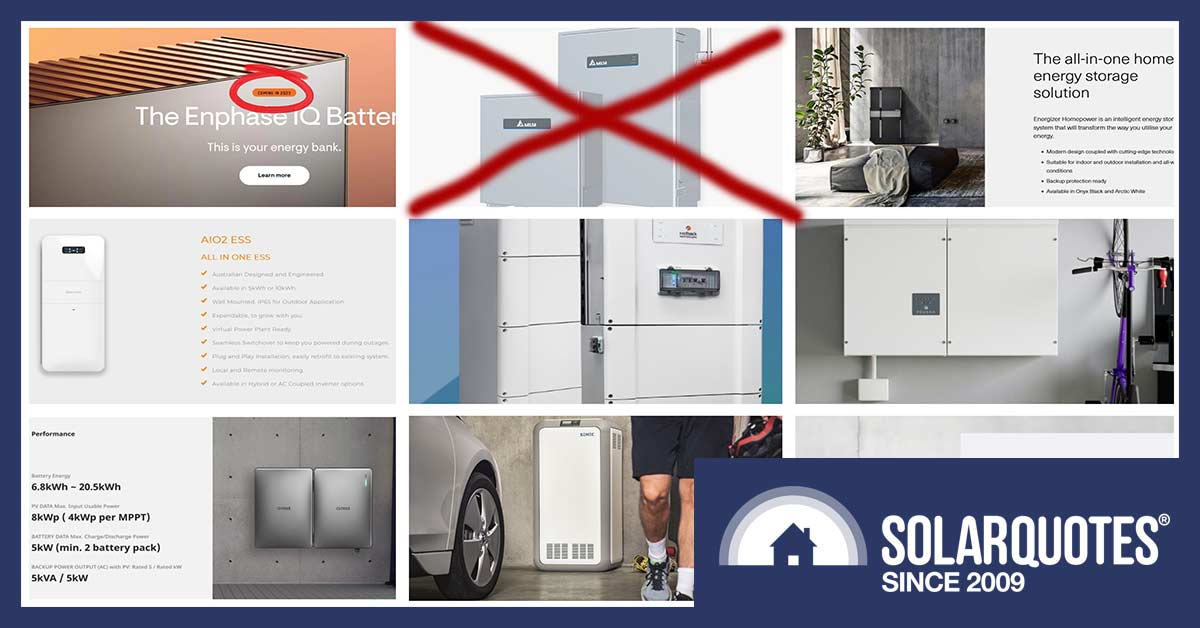
I remember the Tesla Powerwall 2 hitting the Australian market like it was just 7 years ago. It was the shining white pioneer that lit the way, the stroke of marketing mastery, the name now appropriated by an entire industry to describe a brick full of batteries.
It’s the standard that everyone else is trying to emulate because, well, despite the hyperbole, it’s a pretty good product. Consistent feedback from installers all over the country is the Powerwall is a great package. If only everything else Musk touched worked so well.
The problem now is the Powerwall has gone from reasonably priced to reassuringly expensive. So what other options are there?
Powerwall Is Single-Phase, AC-Coupled
There are so many battery configurations it’s easy to be confused. There are 3-phase batteries, single-phase batteries, managed, unmanaged, DC & AC-coupled.
The Powerwall is a single-phase, AC-coupled battery1, so this guide will focus on single-phase AC-coupled alternatives to the esteemed Powerwall.
For home energy storage, this means the battery is charged from 230 Volts AC, and discharges 230 Volts AC. While there are some efficiency losses with AC-coupled batteries, the 230 VAC connection makes them easily retrofittable to your 230 VAC switchboard.
Home Backup
The Powerwall is wired into your switchboard as a parallel supply to the grid, so for blackout protection, it needs an additional “backup box”, which Tesla calls a gateway.
Some of the Powerwall alternatives use a different backup architecture. They have a dedicated essential-circuit output, which means the lights and fridge are wired through the inverter. Be careful with this design. If the battery is some distance from the main switchboard, the losses to get both to AND from the main switchboard can make cabling impractical and expensive.
Top-tip: If your “essential” circuits are wired through (i.e. in and out of) the battery backup system, it’s prudent to have a manual changeover switch installed that bypasses the battery altogether. If the battery system fails, it can be bypassed.
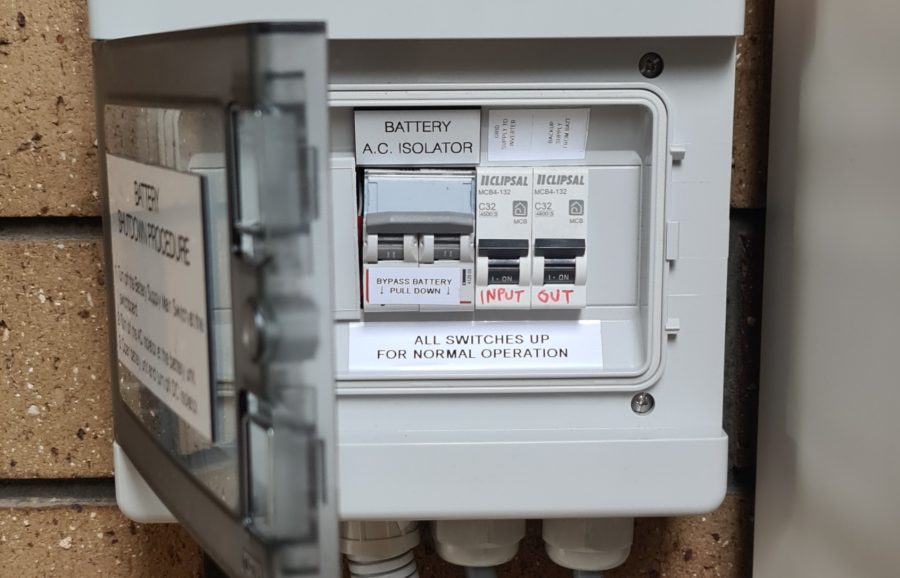
Just imagine an irate customer/tenant/AirBnB customer whose problem can be solved over the phone. Image credit: Solar Depot
Know Your DNSP’s Inverter Limit
As a word of caution – before you roar out and buy a battery for your house, it’s worth getting advice about the rules from your network service provider. The poles and wires people (DNSPs) impose limits on how much equipment you can connect to the grid.
Here in SA, you can have 10kW of inverter(s) connected per phase, with most properties having single-phase, three-phase or occasionally two-phase supplies. So for my particular single-phase example, the plan is for a 4kW and 6kW solar inverter, at which point I am at my maximum 10kW solar inverter capacity as far as the DNSP (SA Power Networks) is concerned.
However, I am also allowed an additional 10kW of battery inverter capacity on the same connection, so my devious scheme is to install a 5kW Selectronic SpPro for storage and bulletproof blackout protection.
The trap is that if you have a hybrid solar and battery inverter, that machine can count toward both allowable totals. If I were to install two 5 kilowatt hybrid machines I could install nothing more. It might be simpler to connect and monitor a hybrid, but it’s likely only one of them would function in a blackout.
Top-Tip: You can see the maximum inverter capacity rules for your DNSP here.
Now you know your maximum inverter capacity, you can work out how many solar panels you are allowed to attach to that inverter.
The STCs that make the ‘solar rebate‘ are capped at a solar-panel capacity that is 133%2 of your inverter capacity. Hence the proliferation of 6.6 kW systems: 5kW x 1.33 = 6.65kW —> cheap!.
But it has recently been confirmed that the 133% doesn’t apply if you have a DC coupled battery.
So if you are planning a battery system, know that the upper limit on your solar panel capacity is limited by the inverter manufacturer. The manufacturer of a nameplate-rated 5 kW solar inverter might specify you can connect 7.5kW or even 10kW of solar panels.
It means a house with 10kW of Fronius solar inverters and a battery can go from the STC-limited 13.2kW of solar up to 15kW. A Huawei or SolarEdge inverter could have 20 kW of solar panels. And with battery storage to soak up the kWhs, you can make better use of all that capacity.
Unfortunately (and in my opinion it’s a little silly) you can’t fully explore oversizing of your solar with an AC coupled battery in the system -the extra capacity has to be attached to a hybrid inverter.
My List Of Powerwall Alternatives
For reference, the Powerwall has:
- Warranty: 70% capacity at 10 years / 37,800 kWh aggregate throughput
- Usable Capacity: 13.5 kWh
- Approx retail: $16 500 + installation (includes Gateway)
- $-per-usable-kWh: $1,222
- $-per-warranted-kWh :$0.44
Tesla claim it’s also stackable up to a whopping ten units. But I wouldn’t recommend doing that.
So in a vague order, the next best options for a single-phase, AC-coupled home battery that I have found might well be:
1. Sonnen Batterie EVO
Shiny white Tesla styling with a German flavour, they’re a first-world machine made in a first-world country to solve first-world problems. The sonnenBatterie has, to my mind, a reassuring feature: it has specific specifications, and more of them. If a manufacturer is willing to tell you more about the product, they’re more confident it will meet the requirements they’re setting out for themselves.
For example, despite the nominal rating of 5 kW or 22 amps, Sonnen specifies a very respectable 7.05 kVA of backup capacity for 60 seconds and 5.3 kVA for 30 minutes3.
In short, because there’s surge capacity available to do more than the nominal figure, they’re promising that, at the very least, it’ll do what it says on the tin.
Lithium Iron Phosphate chemistry is a safe bet (without the shorter life or perceived questionable ethics of cobalt in an NMC battery) IP56 rating means it can certainly be an outdoor unit, and it accepts 6kW of compatible solar inverter.
The essential circuits, i.e. ones that are blackout protected, are wired through the Sonnen. While I haven’t installed one myself, I have examined the newest model first-hand. From an installer’s perspective, they are a nice design with neat weatherproof packaging.
If you hammer this battery and cycle it multiple times per day, perhaps with an aggressive VPP, Sonnen’s 10-year 100,000 cycle warranty looks attractive.
- Warranty: 80% capacity at 10 years / 10,000 full cycles (100,000 kWh) – whichever comes first
- Usable Capacity: 10 kWh
- Approx retail: $14,000 + installation
- $-per-usable-kWh: $1,400
- $-per-warranted-kWh : $0.38 if cycled once per day, $0.19 if cycled twice per day4.
2. SENEC.Home
Apart from using Samsung SDI battery modules from South Korea, the SENEC.Home V3 is designed, manufactured and assembled in Germany. It’s a pretty compact floor-standing unit; 1135 mm tall with a 535 mm square footprint, cables enter from the rear as seen in this video. With an IP30 ingress rating, it must be installed inside and doesn’t offer a wall mounting option, so you’ll need to consider where it goes.
With space for two battery packs, the Senec has either 4.5 or 9 kWh of usable storage. The backup circuits are wired through the unit, and it offers a disappointing maximum 3.5 kW of battery power.
The sales material claims:
“100% capacity guarantee for the first 10 years”
…which appears to differ from the warranty documentation offering 75% at ten years or 12,000 aggregated cycles. Interestingly there is a further 10 years warranty available for purchase (if you have solar panels). However, this doesn’t buy you any more cycles, just more time, and has some curious $450 excess payments should you call on the warranty.
With offices in Victoria and Western Australia, they assure us the local agents are available for support over extended hours. I can’t vouch personally for the service, but it’s certainly had a good review from someone I trust.
However, while this story from Germany raises some questions, it also highlights the importance of a solid internet connection and a reputable manufacturer who takes a proactive approach to monitoring. It’s damage control in more ways than one.
- Warranty: 75% capacity at 10 years / 12,000 cycles (108,000 kWh) – whichever comes first
- Usable Capacity: 9 kWh
- Approx retail: $14,000 + installation
- $-per-usable-kWh: $1,555
- $-per-warranted-kWh :$0.43 @ 1 cycle per day / $0.21 @ 2 cycles per day
3. Q.cells Q.HOME CORE A5
Qcells assures me that the AC-coupled Q.Home battery (suffix A5) exists, even though the website only refers to the H5 DC-coupled, hybrid model, which I found curious5. The hard-to-find A5 datasheet is here.
It has to be said that if you do choose the A5 model (instead of the H5 hybrid), your existing solar system cannot charge the battery. Blackout protection is limited to the energy stored in the battery. There’s no ability to black start the battery if you flatten it overnight, so extended off-grid autonomy isn’t available.
One point that seems to set Qcells apart is their monitoring platform will integrate with Samsung Smart Things, so you can stitch together more things in the quest for more energy efficiency. And if we’re being honest, the kilowatt you never needed is always the cheapest.
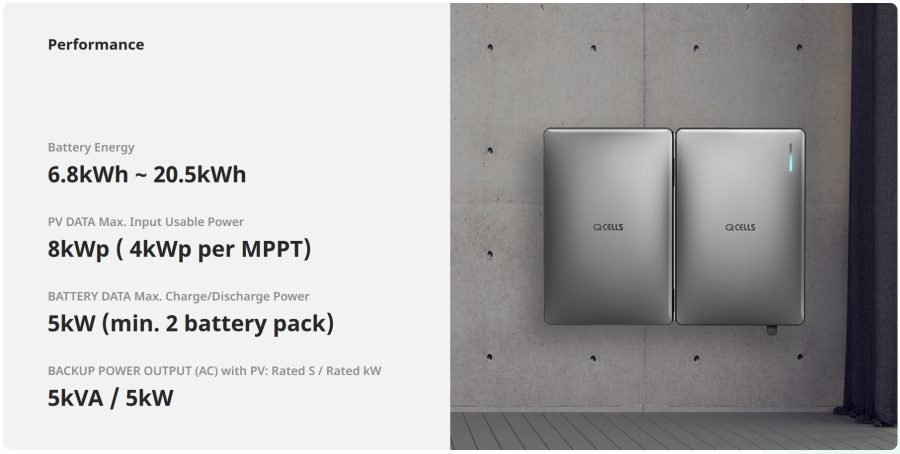
It’s all colour-coded shades of greige.
In performance terms, the Qcells A5 is a respectable 21 amps or 5 kVa. The surge capacity isn’t quite as stout as some, but it is reassuringly specific: 5.5 kVA for 30 seconds, 6.0 kVA for 20 seconds, 6.5 kVA for 10 seconds, assuming you have more than the minimum number of batteries.
The batteries themselves are Lithium-ion NCA (Samsung SDI, used by a number of other manufacturers as well). They come in nominal 6.8 kWh increments, so you can couple up two more packs for a total of 13.7kWh or 20.5kWh of storage. Rated usable energy in kWh is 6.51 / 13.03 / 19.55.
It’s a nice looking device that can be wall or floor-mounted. While I don’t have first-hand experience with installing one, I have seen enough to know a fussy customer will probably need a cable duct and a talented electrician with the time to make the wiring entering the bottom of the packs look nice.
Now for the warranty. Qcells make a great deal out of being a solid company with an Australian office offering a 15-year warranty and good on them. If the marketing is to be believed, the extra five years makes a great deal of difference for your return on investment, and if it keeps it functioning on your wall instead of being replaced, that saves on invested energy, then we all win.
Qcells have a very specific formula to reduce their liability if the battery is operated outside its preferred temperature window, so they want you to have an internet connection. The warranty compensation paid after two years is pro-rata. I was relieved to see Australian Consumer Law does rate a mention further on in the document, so I would hope you could nail them for a replacement if it suffered a major failure inside of maybe 10 years?
- Warranty: 60% capacity at 15 years / 29,500 kWh per 6.86 kWh module
- Usable Capacity: 6.5 / 13 / 19.5 kWh
- Approx retail: $12,000 + installation for 6.5 kWh
- $-per-usable-kWh: $1,846
- $-per-warranted-kWh : $0.40
4. Eguana Evolve
Partly assembled right here in Adelaide the Eguana Evolve is a fairly gutsy package with an inherently safe galvanically isolated inverter, 5 kVA nominal and 170% or 8.5 kVA surge capacity (provided you buy a third battery for 19.5 kWh total storage).
Starting at 13 kWh storage (2 batteries) the Evolve can be grown in increments of 6.5 kWh up to 39 kWh. It uses LG Chem batteries with NMC chemistry, and the whole package is in an IP34 rated fan-cooled box.
Warranty is ten years, 19.2MWh throughput, 60% capacity, pro-rated.
Eguana were posting on Google giving away FREE* holidays some days ago, but despite reaching out a couple of times for more specific information, Eguana hasn’t been forthcoming so far. This worries me a little because the spec sheets available from the US don’t tally exactly with the Australians claiming to have locally made batteries.
- Warranty: 60% capacity at 10 years / 19,200 kWh per 6.5 kWh module- whichever comes first
- Usable Capacity: 12.2 – 36.6 kWh
- Approx retail: $14,500 + installation for 12.2 kWh
- $-per-usable-kWh: $1,189
- $-per-warranted-kWh :$0.38
5. Redback SB14200
The Redback SB14200 comes with 4.5 kVA or 19.6 amps output. Offering a 10-year warranty and 14.2 kWh of storage (4.8 to 28.4kWh models are available), I think if you scratched the paint off, you’d find it was actually a Goodwe inverter powered by 4 Pylontech LiFePO4 batteries. But that’s really nothing to be sneezed at.
IP54 rated with convection cooling makes them weatherproof and quiet. The essential circuits are wired through the Redback unit and while I haven’t installed one from scratch, I have certainly had the covers off and done enough work on them to verify it’s a nicely built all-in-one package that is very neat when installed. Plus they’re backed by a well-established Australian organisation in Brisbane.
Better still, those banana benders are putting quite a lot of local content into the package. The software, the switchgear, the monitoring portal are all designed onshore to meet local conditions and rules.
This isn’t a case of badge engineering.
Redback has a broad range, also offering hybrid 3-phase options and modular off-grid products that will be covered in later posts.
I can confidently say that Redback offer 10 years warranty on their products, however after searching and finding QR codes with expired links, I reached out to Redback for some specifics, and they happily obliged, which is excellent. I can hardly begin to explain how important it is to have good local after-sales service.
- Warranty: 10 years – battery degradation not specified
- Usable Capacity: 12.6 kWh
- Approx retail: $13,500 + installation
- $-per-usable-kWh: $1,071
- $-per-warranted-kWh :$0.27 @ 1 cycle per day / $0.14 @ 2 cycles per day
Update 15 November: Redback have informed us the approximate retail cost the company originally provided ($16,500 + installation) was incorrect. Excluding installation it would be approximately $13,500. We’ve updated the above bullet points to reflect this.
6. Soltaro AIO2 5KW/10kWh
Having spoken to the Soltaro National Manager at the recent All Energy Conference, I can assure you he is confident that this is a pretty solid offering. Of course, he would say that, but I’ve not heard anything to counter that position elsewhere around the traps. They appear to be yet another neatly presented package.
Reading the spec sheet, you begin to get the feeling these things are all a little generic. Like the Redback or Qcells systems mentioned earlier, they are available as AC coupled or hybrid, IP64 rated so they certainly can be installed outside, despite the glossy brochure showing no less than four photoshopped images of illegal installs inside the home(!)
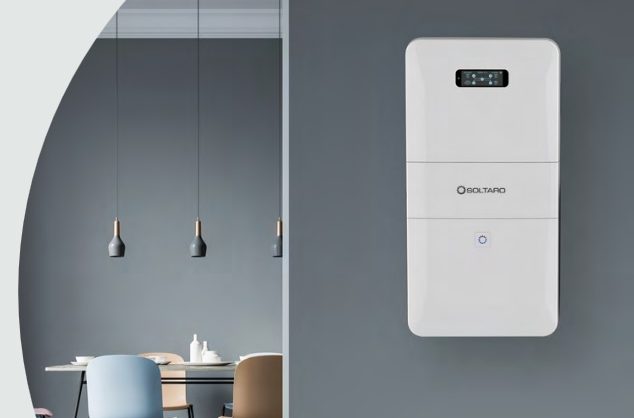
Other things simply don’t belong. No matter how well styled, this battery, in a habitable area of your home, is illegal.
Batteries are LiFePO4 chemistry with a nominal 5kWh capacity, meaning the 10kWh unit has a 9kWh useable capacity.
The output specifications operating to power your essential loads are very simply put as 5 kVa and 21.7 amps with no other qualifications. In my experience, that means there’s no surge capacity beyond that figure. What proves interesting is if you trawl through the manual, they specifically declare a surge output of 5.5kVa for 10 seconds.
Now that’s great that they state it, and great they’re honest enough to go on further in writing. What disappoints me is that the backup circuit is not suitable for inductive loads. To underline this, there is a 2.5 kVa limit imposed for total inductive load. Why does that matter? Well, because it will struggle to start your fridge.
Lights, TVs, computers and phone chargers don’t use much energy and don’t cause much disturbance to the supply. Things with electric motors, such as your fridge, freezer, rainwater or aquarium pump are inductive loads. They distort the AC supply, and worst of all, they often need seven times their rated current when they start up. Thankfully more things are now being built with “soft start” circuits, which means they’re less demanding.
After you’ve shelled out for any of these inverters to be screwed to your house, you don’t want to find turning the kitchen tap on kills the power, or having the fridge running means you have to unplug the freezer to keep the lights on. It would be particularly annoying to find out your sales brochure says 5000 watts while the fine print in the manual full of fuzzy pictures says 1500 watts is all it will handle for a single motor.
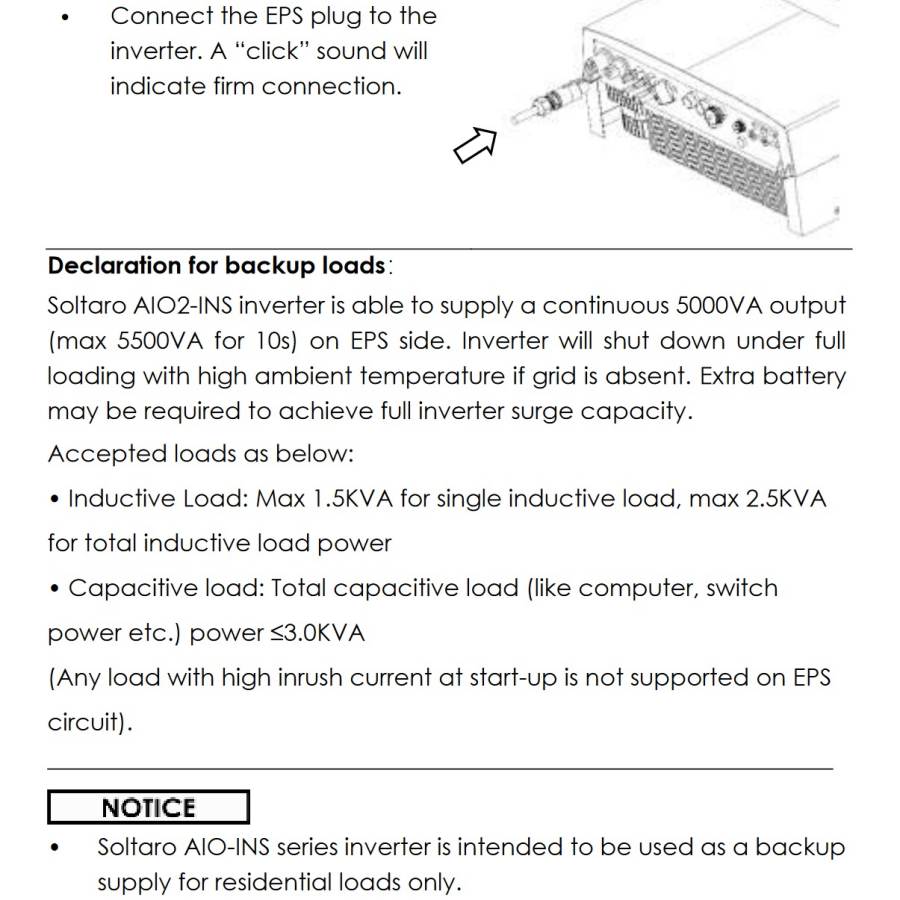
This isn’t the worst manual I’ve seen, but the language is a little quaint, and the pictures appear to have been photocopied from a hand-cut potato print.
Warranty is paid out pro rata or with extra batteries, while your retailer appears to be on the hook for a lot of the warranty process if things go pear-shaped.
- Warranty: 70% capacity at 10 years / 75,000 kWh
- Usable Capacity: 9 kWh
- Approx retail: $14,300 + installation
- $-per-usable-kWh: $1,588
- $-per-warranted-kWh :$0.43 @ 1 cycle per day / $0.21 @ 2 cycles per day
7. Energiser Homepower HP6
Can you sense a theme emerging in compact all-in-one battery energy storage systems? Here we have another 10-year/10,000 cycle LiFePO4 offering that’s AC-coupled for both new and retrofitted installations; convection cooled, with IP65 weatherproofing and blackout protection offered on an essential circuit rated at 16amps or 3.6kW.
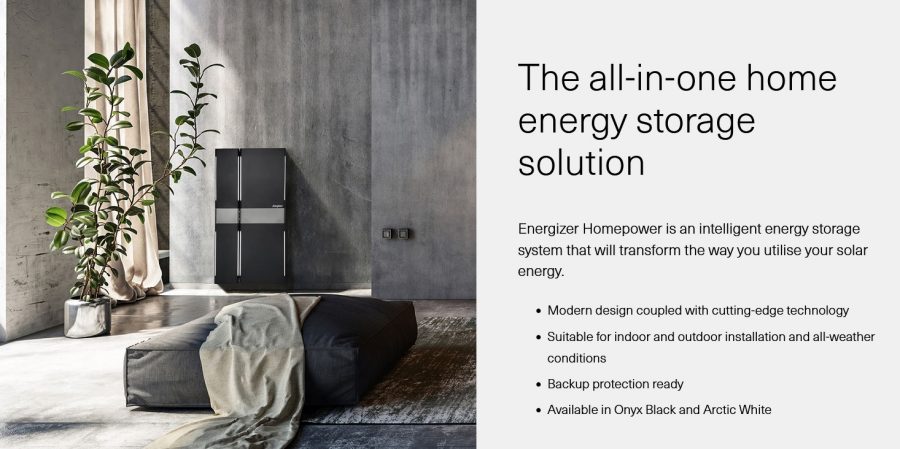
Maybe I’m missing something, it might be a sexy-looking battery, but it’s still illegal to sleep with one.
Perhaps the most distinctive feature of this unit is the “Patented Magna-Flap“. If you’re in a cruel mood, you might also describe this as “a hinged greige cover for the buttons”.
Nominal storage capacity starts at 6.1 kWh, expandable up to a healthy 24.4kWh. With a full stack, you could almost charge an early model Nissan leaf in something under 7 hours, but please don’t hold me to that calculation because I have to admit I’ve never clapped eyes on one of these things.
The warranty document says you’ll want a reliable internet connection. Otherwise the warranty will be cut to 4 years. It also clarifies that useable capacity is 95% of nominal capacity and assuming “normal operation” after 10,000 cycles there should be a pretty healthy 80% of that useable capacity left. There is a table that specifies a “Total Energy Dispatch of 3 MWh per kWh” if you’re using it for “other applications”. However the definition for that is anything that isn’t “normal operation”.
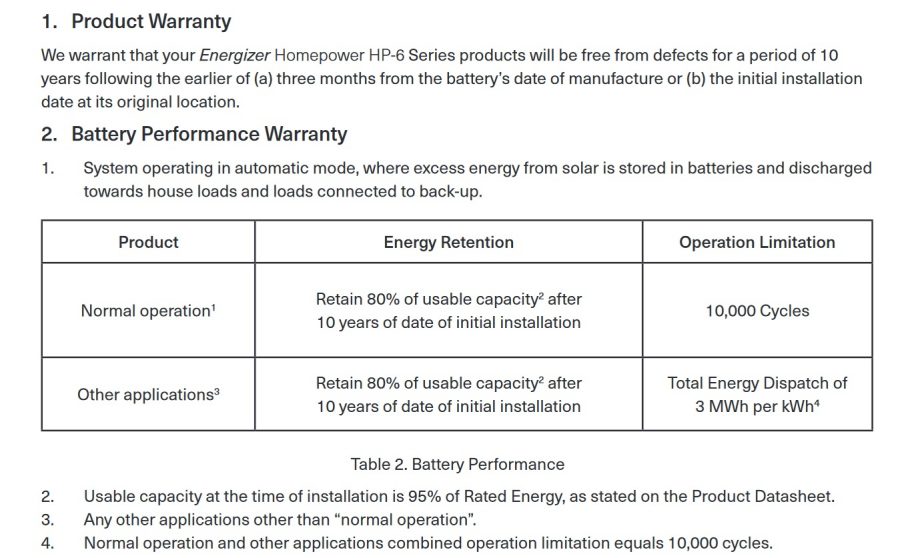
It reminds me of the sign in Mum’s kitchen… Rule #1 The boss is always right. Rule #3 If the boss is wrong, refer to rule #1.
What is refreshing about the Energiser package is the specifications are pretty comprehensive. The PDF flyer isn’t just moodily lit product shots and glib catchphrases about brands you can trust. There’s a straightforward list of dot point features and, best of all, a system diagram that would look right at home in a decent install manual. Little details like having the measuring coils (CTs) pictured and cable lengths specified mean that, as an installer, I have a good idea if this will work at your house, or how far away from the switchboard it can go.
- Warranty: 80% capacity at 10 years / 42,340 kWh
- Usable Capacity: 11.6 kWh
- Approx retail: $14,000 + installation
- $-per-usable-kWh: $1,206
- $-per-warranted-kWh : $0.33
8. Delta Residential / BX6.3_AC100
The model number is quite informative here, while the technical specifications are, by comparison, pretty basic. The unit has 6.3k Wh of AC coupled battery which offers a lowly 3 kW or nearly 14 amps of peak backup capacity.
The Delta is IP65 rated for weather protection and uses convection cooling, so it’s quiet; using well-regarded Samsung Li-ion cells.
With the option of a second module, the EX_6.3 Delta can extend storage capacity to nearly Powerwall size while the backup specification increases to a healthy enough 4.5 kW or just over 20 amps peak.
Unfortunately, the warranty is for only 50% capacity.
So scrap that. In my opinion, with the pitiful warranty, you should not consider this a Powerwall alternative.
9. Enphase IQ Battery
The Enphase IQ Battery is coming. In fact, it’s been coming for at least five years now. But I’ve included it here because we expect it be a nice product. Soon. Maybe.
Details so far announced say the Enphase IQ Battery 10™ has a total usable energy capacity of 10.08 kWh with a dozen embedded grid-forming microinverters under the bonnet for redundancy. Together these provide 3.84 kW of backup capability via the IQ System Controller, which houses the Smart Switch, the Enphase IQ Gateway, Circuit protection, Power Control and anti-islanding protection required by Australian and New Zealand standards. Up to 4 batteries can be stacked for a total of 40kWh storage.
In the past, they have promised it’ll be here by Christmas… without actually specifying which year. Aside from “Q3 2022” or “coming 2023”, we are still none the wiser as to when it finally lands.
Stay Tuned For Updates
This post gives seven options if you want to retrofit batteries to an existing, sufficiently good solar system. In a later post, I’ll try to sort the very crowded field of hybrid solar and battery inverters. These will be ideal systems for newcomers starting from scratch or those who want to upgrade to a complete new solar and battery system to sit beside or replace their existing panels and inverter.
To be notified of new posts on batteries, inverters and other solar bits, sign up for our weekly newsletter. Also check out SolarQuotes Founder Finn Peacock’s comprehensive and easy-to-understand guides to understanding, buying and owning home batteries.
Footnotes
- Although single-phase, it can happily be used on a single phase of a three-phase house ↩
- Technically it’s 1➗75% ↩
- without going into reams of electrical jargon, consider kW as analogous to kVA even though they aren’t quite ↩
- most likely scenario to consistently cycle a battery twice a day is if you charge on solar, drain for the evening peak, then recharge overnight and drain in the morning peak ↩
- Qcells assures me that the website will be fixed soon ↩

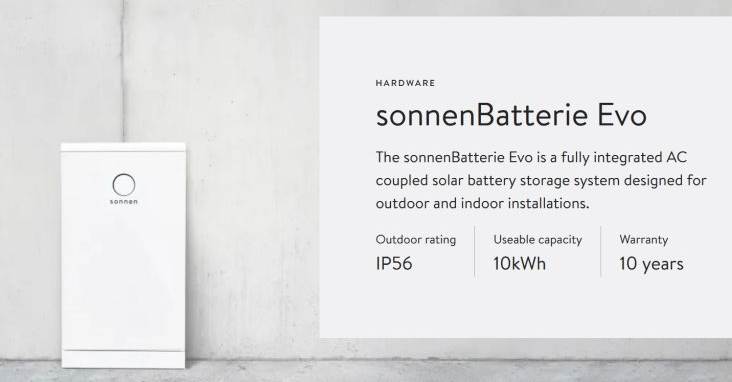
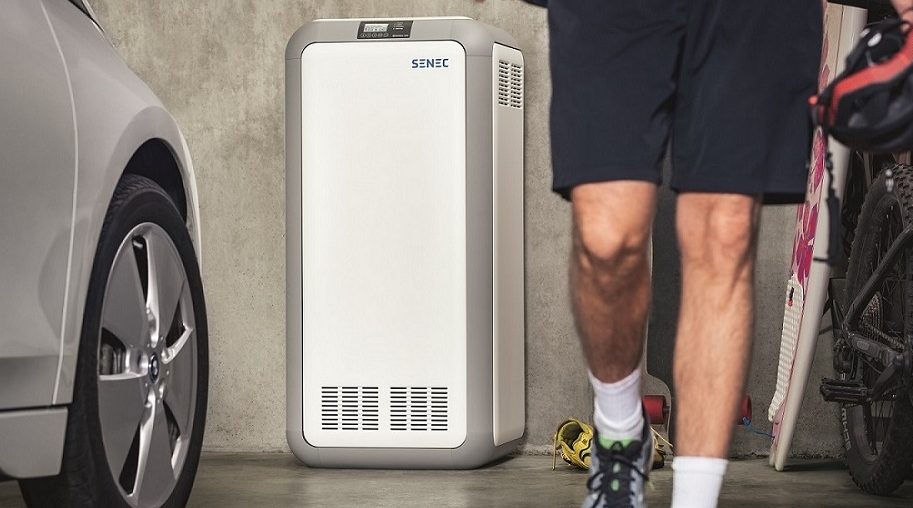
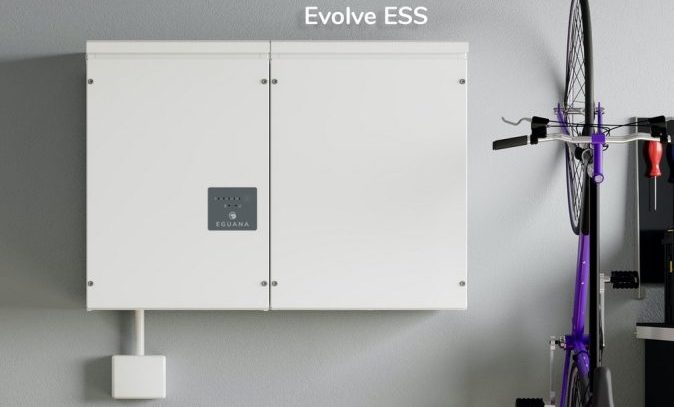
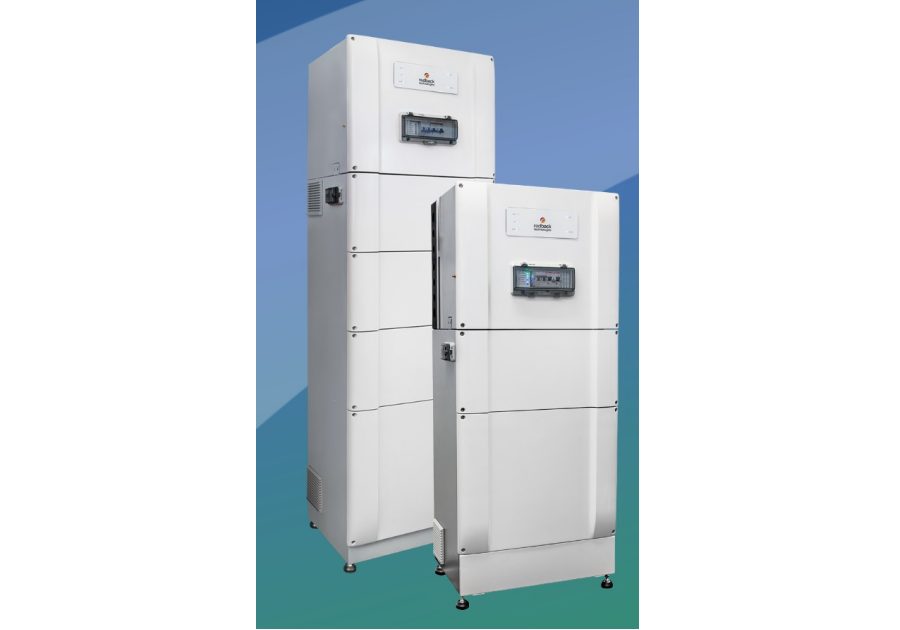
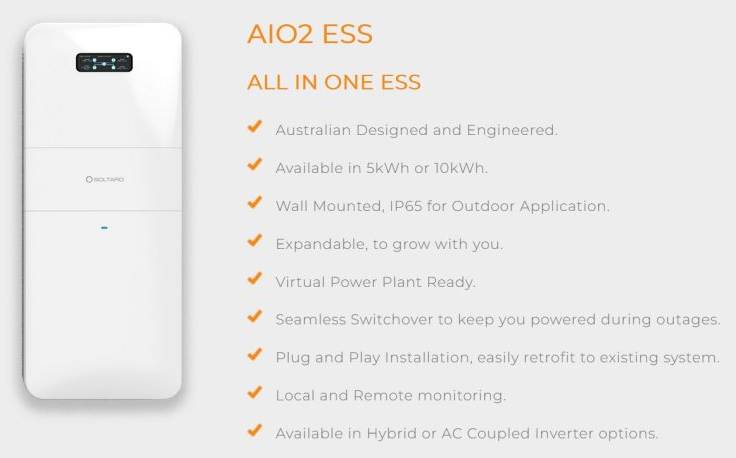
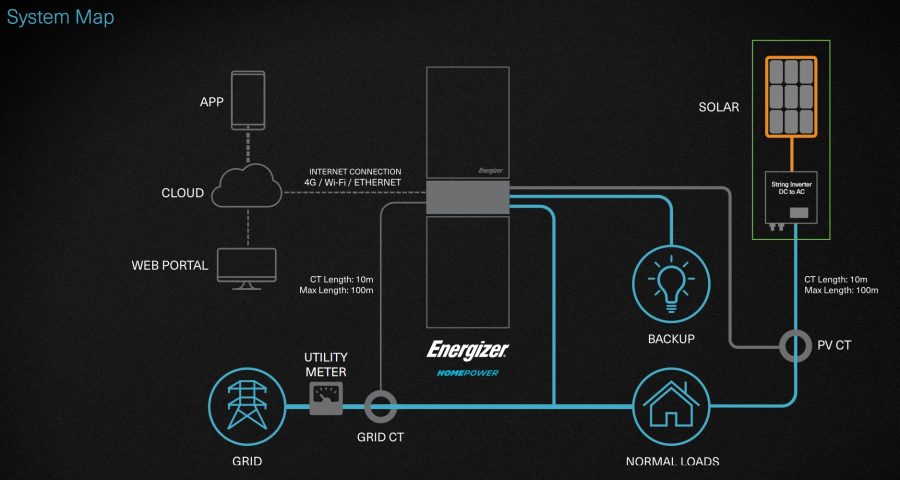
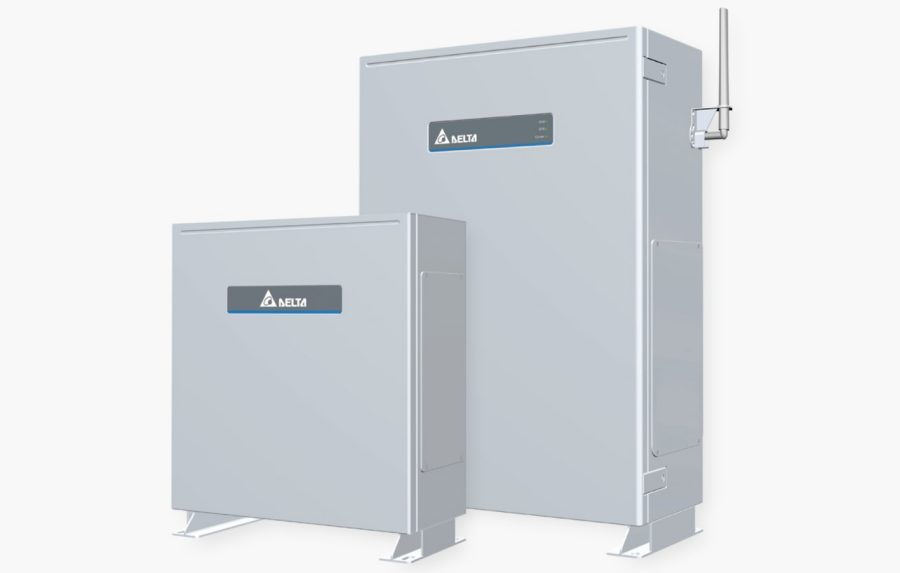
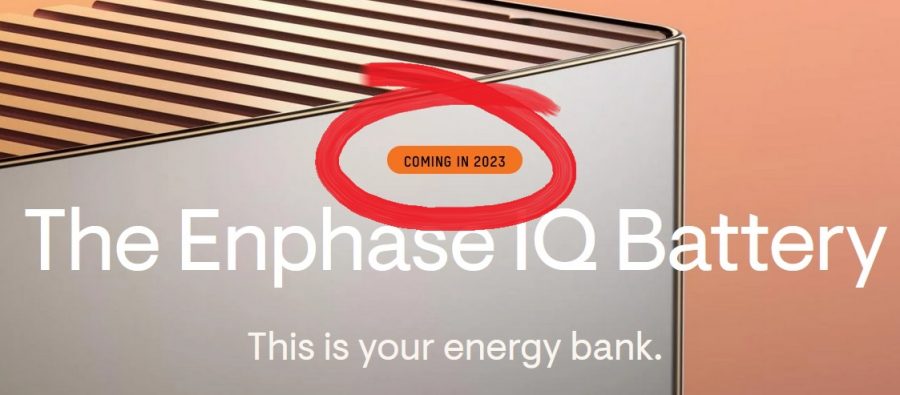
 RSS - Posts
RSS - Posts



After such comprehensive comparison with standardised metrics (well done), it still makes the Powerwall look pretty good. And having installed or worked on a few of these, and many other energy storage systems both on and off grid, I know which one delivers the best customer experience by far…. Powerwall, once again. As much as I despise the ego-centric way in which Tesla came to market, I have had to admit they have delivered beyond expectations..
So which are the batteries for 3 phase setups? I have lost the plot soon after the opening remarks.
wrong spot
Yes, despite the size of the twisted ego that is the CEO of Tesla, we have to ignore that, we’re not buying because the CEO’s personality (same thing applies to Apple’s Jobs). It’s the engineering behind the product that’s more important
Tesla PW would be considered “best of breed”, it has the right combo of features that would meet the wants of most house owners and/or other commerical interests (e.g, PowerPack, MegaPack, etc).
One of the critical things I would find I important is ongoing firmware/software updates at no charge and done automatically. How many these other batteries offer the same service?
Love him or loathe him there’s no denying he has done more to speed up the energy transition than any other individual.
Quite an extraordinary businessman.
Odd -m the Powerwall seems to be the cheapest of any supplier per usable kWh. It’s a shame you couldn’t come up with some more budget options. Also it would be nice to know which of the AC couple batteries work in island mode with a three phase inverter? I don’t know if any of them do.
“nice to know…. batteries work in island mode with a three phase inverter” – exactly!
My solar project is hibernating until there is a proper island mode battery
inverter solution (for 3 phases) on the market.
Sorry Eguana is marginally cheaper although it definitely only offers single phase backup.
What about the new SolarEdge battery?
Hi Kim,
We’ll include the SolarEdge unit in the next exciting installment of -hybrid- inverters.
In the meantime have a look here :
https://www.solarquotes.com.au/blog/solaredge-home-battery-review-2/
https://www.solarquotes.com.au/blog/solaredge-home-battery-review/
Cheers
A further option would be a Nissan Leaf and others offering V2H, but with cheaper bidirectional chargers. One would think as Japan has legislated V2H, it would be possible to afford those from Japan, but not so.
Despite all that, the cost of a bidirectional charger plus installation is still cheaper than a 10kWh battery vs. a minimum of 60 kWh in a vehicle being available and Nissan does not derate the warranty if used for V2H.
I’m watching this V2X space eagerly, and will be needing a 3phase bi directional charger. An EV presents a solid solution when combined with an EV with 40-70kWh battery.
It looks like its still a couple of years away, and I’m curious if anyone has a battery/EV connected to an offpeak circuit to recharge at offpeak times, and supply to the regular house circuits (including 3 phase)
VPP calculation would also be an interesting calculation if the above is achievable.
One big plus for the Powerwall is the smartphone App that allows me to check the power flow and take action to optimse my use of solar and off-peak electricity.
For example, today I started charging my PHEV car when I saw that the Powerwall was almost fully charged and the solar export to the grid exceeded the 2.4kW that the car uses. At other times the car charges from off-peak at night (it is on a smart switch).
I have suggested to Tesla that the app has a feature to alert users if the export to the grid exceeds a certain amount (or better still, be smart-home compatible).
My experience is that the Tesla app developers are very responsive to user feedback like this. There have been several updates (not at my request) that have added useful features over the 4 years I have had the Powerwall.
The powerwall app seems to get worse at every update.latest update v15.3 (Dec 2022) on latest android no longer allows 5 minute data to be downloaded. Power failure history removed several generations ago. Min charge level now set to 5%. I used to have mine lower. Poor resolution of data. 0.1kW. Energy should be in kWh, not kW. Email for developer at app store is not monitored. I have been unable to report bugs to tesla despite searching on Web. I did find a support chat sites but gave up after waiting for half an hour. Have had Powerwall more than 3 years Hardware had no trouble. Software is poor. I and from Web many others wish Tesla will put things enable feedback. I also wish Tesla would have a separate app for the powerwall from the car. Reading ratings for the app on Android has very low average ratings for powerwall and high ratings for the car. Having separate apps might improve the powerwall app.
Interesting feedback thanks Keith, from an installer point of view the Powerwall has been a winner but you raise some valid points for the one who’s spending the money.
Cheers
Not worth the money
Why?
Cars have the same problem…..
Why are we actually buying batteries is just as reasonable as buying a car. No car will ever return the money spent on them (except for vintage or collectibles).
$-per-usable-kW? Should that read $-per-usable-kWh???
Because kW for each battery is not the same as the PW at 5kW and the kWh capacity is different, so Tesla seems to be best value.
When I got my battery (TPW2 with full house backup installed) was $870/kWh. (2017).
I thought batteries were supposed to be going down
Glad to see the redback is there. Got one going in tomorrow. let the gamble begin 🙂
Why do RedBack Batteries say in really really really small writing
Country of Origin China
According to the company website they’re designed in Australia and there’s customer support in Brisbane. If the batteries say country of origin China on them then presumably actual manufacturing isn’t done here but the company doesn’t want to announce that.
Because the battery modules are from Pylontech, a Chinese company. Pylontech seems to have more reliable performance than most <>
Let’s not forget about Zn-Br flow batteries (eg. Redflow ZCell v2 or v3), which currently have a higher capital cost, but probably equivalent TCoE cost to its alternatives, PLUS the ability to refurbish at end of life (instead of burying it in the ground with all our other ultra-persistent and toxic post-WW2 rubbish), PLUS it won’t catch fire and burn you to death in your sleep, PLUS 0-100% capacity cycling throughout its lifetime.
It’s currently the best available battery technology in the world for static (such as household) applications.
Hi,
Is there any reason why the Red Earth systems are left off this? https://redearth.energy/our-products/on-grid-systems/
I note they are an Australian manufacturer, and I am keenly interested in the competitiveness of their offer vs the likes of the Tesla PW.
No! As the former Australian Prime Minister Paul Keating once said that he would tell the truth, “I will not gild the lily”. Batteries ? are beautiful, but if there not made in Australia, then they are not made in Australia. The Red Earth ‘batteries’ ? are Made in China, period.
They’re coming Mitch, sorry about the delay but there are hundreds of models to consider and review and chase information for. Hybrid inverters are next.
Cheers
How far away are we from being able to use EVs as house batteries? Cheers
There is ONE approved install in Australia at the moment, we’ll have an article written for it as soon as the embargo is lifted.
Cheers
here it is: https://www.youtube.com/watch?v=0MBq5KPORGk&lc=UgyOukJnMjhf7pscaXt4AaABAg
Hey, no BYD? Any reason for that?
They’re coming Maree, sorry about the delay but there are hundreds of models to consider and review and chase information for. Hybrid inverters are next.
Cheers
I am enjoying my ROSEN power wall for my off-grid set up. Had it a year now and no problems whatsoever. About a third of the cost of a Tesla.
Compared to the cost of batteries in EVs storage systems have been a huge rip-off. Certainly Musk made a shit-load of money out to Tesla Powerwall.
Imagine trying to sell EVs if they charged what Tesla charges for batteries in the Powerwall?
Can you please comment on GenZ batteries, 3kWh Series 3.
Thank you
Why no Alpha ESS?
We’ve installed heaps of the Smile5 13.34kWh with no major issues. They pretty much beat everything here on specs and they are well made and well priced with good after sales. They have an excellent online dashboard and you can add up to 5 additional battery modules for a total of 80kWh!
Hi Simon,
I’ve installed alphas myself. The manual had pages printed upside down, in a tiny font and quaint english. After a few attempts the second support call that actually got answered got me an email full of common problems. My particular install had to have to battery misidentified in the commissioning process and an rj45 plug cut off and reterminated. This proves they knowingly shipped a product that wouldn’t work, straight out of the box it needed modification.
https://www.solarquotes.com.au/blog/alphaess-battery-warranty/
Cheers
No Huawei Luna 2000??
Or Pylontech (the only one that was still standing at the battery research place)??
They’re coming Gary, sorry about the delay but there are hundreds of models to consider and review and chase information for. Hybrid inverters are next.
Cheers
THANK YOU
Hi Anthony,
Really appreciated reading this article.
Looking forward to the mentioned follow-up reviews of the hybrid inverters, other brands and three-phase systems.
Best wishes,
Andrew
No worries Andrew,
We always hope these articles live longer than a couple weeks. If you’d like to catch up on the hybrids the initial article is here :
https://www.solarquotes.com.au/blog/powerwall-alternatives-hybrid-inverters/
As we do more detailed reviews and 3 phase updates you’ll see the models listed become active hyperlinks like this one…
https://www.solarquotes.com.au/blog/selectronic-sp-pro/
https://www.solarquotes.com.au/blog/powerwall-alternatives-hybrid-inverters/
Don’t forget you’ll likely need some love in the switchboard too.
https://www.solarquotes.com.au/blog/solar-switchboard-upgrade-guide/
Cheers
Missing the Fronius Gen24 and BYD HVS/HVM combination. Works very well in our place, can handle blackouts with allowing the PV system to keep supplying the house and charging the battery. I believe the PowerWall doesn’t have this function. The HVS has a high peak capacity.
Hi Hank,
We’ll be putting out a few more of these posts soon so watch this space 😉
This is the more general information
https://www.solarquotes.com.au/blog/powerwall-alternatives-hybrid-inverters/